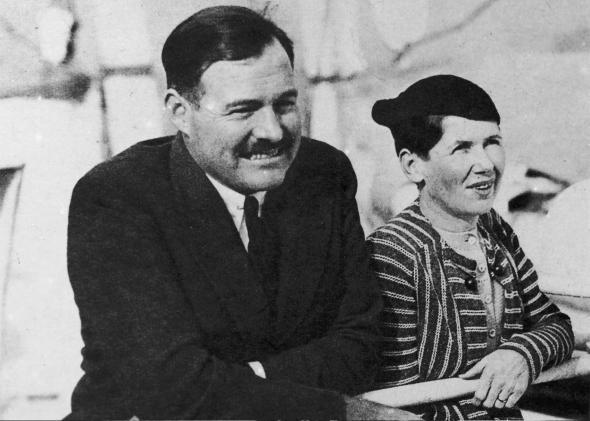The latest issue of Smithsonian magazine contains an excerpt from the forthcoming book Hemingway in Love: His Own Story, a memoir by Ernest Hemingway’s close friend A. E. Hotchner. Hotchner, a 95-year-old writer and editor, is perhaps best known for the 1966 biography Papa Hemingway, but in his new book, he has selected a narrower frame through which to consider the literary icon.
In 1961, just weeks before Hemingway’s suicide, Hotchner visited him in the psychiatric ward of St. Mary’s Hospital in Rochester, Minn. There, Hotchner became the unwitting audience to an extended retelling of the story of the affair that destroyed Hemingway’s first marriage (to the devoted and well-to-do Hadley Richardson) and turned into his second marriage (to the glamorous journalist Pauline Pfeiffer). Hotchner had the presence of mind to whip out an audio recorder. Decades later, he still feels that these early romantic travails propelled both the turbulence of Hemingway’s life, and the blunt loneliness of his fiction; he sets out to tell the tale that he believes his friend “entrusted to me with a purpose.”
If the purpose of this tale is pathos and revelation, the effect on the reader—or at least on me—also includes a whole lot of gratitude that “Papa,” with his singular brand of pugilistic chauvinism, is no longer considered the paragon of literary manhood. I never thought I’d say it, but give me Jonathan Franzen any day.
What follows are the most Hemingway lines from the excerpt of this ribald new Hemingway memoir.
• Here’s the first thing Hemingway—or “Ernest,” as he’s referred to in the book—tells Hotchner about Pfeiffer: “First impression? Small, flat-chested, not nearly as attractive as her sister.”
Here’s the first thing Hemingway tells him about Richardson: “Hadley was the only woman who mattered in my life, her full body and full breasts, hair long to her shoulders, long-sleeved dresses at her ankles, little or no jewelry or makeup. I adored her looks and the feel of her in bed, and that’s how it was.”
“Flat-chested” versus “full breasts”—I’d say that settles it!
• Hadley “lived her life loving the things I loved: skiing in Austria, picnics on the infield at the Auteuil races, staying up all night at the bicycle races at the Vélodrome, fortified with sandwiches and a thermos of coffee, trips to alpine villages to watch the Tour de France, fishing in the Irati, the bullfights in Madrid and Pamplona, hiking in the Black Forest.”
Whether Richardson would have “lived her life loving” these things because she herself loved them is, of course, immaterial. But FWIW, “Pauline wasn’t nearly as good as Hadley skiing or horseback riding, shooting, fishing, name it.”
• Yes, Papa strays, but it’s totally Pfeiffer’s fault. She liked to “corral” him for drinks. “She had the ‘I get what I want’ hubris of a very rich girl who won’t be denied.” He held out until he started writing The Sun Also Rises; that process was a “fever,” “an out-of-control brush fire that swept me into Pauline’s maw.”
• At first, double-dipping has its upsides. “[A]fter a really tough day writing, there’re two women waiting for me, giving me their attention, caring about me, women both appealing, but in different ways. … Stimulating, fires me up.”
As Hemingway told Scott Fitzgerald: “Hadley was simple, old-fashioned, receptive, plain, virtuous; Pauline up-to-the-second chic, stylish, aggressive, cunning, nontraditional.” They also differed in more private arenas: “Hadley submissive, willing, a follower. Pauline explosive, wildly demonstrative, in charge, mounts me. They’re opposites. Me in charge of Hadley and Pauline in charge of me.’”
• When Richardson leaves Hemingway, he remarks, “I had contrived this moment, but I felt like the victim.” Hemingway and Pfeiffer marry, then divorce: “I’ll tell you when I threw in the towel on Pauline… When she announced she was going to have another baby. The first one had made me bughouse and a second one, howling and spewing, would finish me off.” At one point, he asks Hotchner, “You ever loved two women at the same time?” Hotchner says he hasn’t. “Lucky boy,” says the poor, noble, ill-fated Hemingway.
Of course, anyone familiar with the Hemingway saga will know that he married twice more, to two more pioneering women journalists: fearless war reporter Martha Gellhorn and foreign correspondent Mary Welsh. Readers may be surprised to learn that, despite those passions, the writer seems to have spent the end of his life idealizing the beginning—the youthful sweetness of his first literary successes and first marriage.
What’s sadly not surprising is that—in Hotchner’s account and in history—the women who shared their lives with Papa, supporting his brilliance emotionally and financially, rarely get to speak. Hotchner’s book is “just one side of the story, Hemingway’s side,” Naomi Wood, who wrote a book about Hemingway through the eyes of his four wives, told The Guardian. “The love letters he sent to Pauline were just as emotional and sentimental and desiring as the ones sent to Hadley.” In fact, Pfeiffer, portrayed by Hemingway and Hotchner as a self-possessed temptress, is the most absent and agentless in the telling of history. Says Wood: “Hadley spoke to several of the biographers, Martha Gellhorn had her own status, and Mary wrote a memoir. Pauline is the only one who never has a say.”
